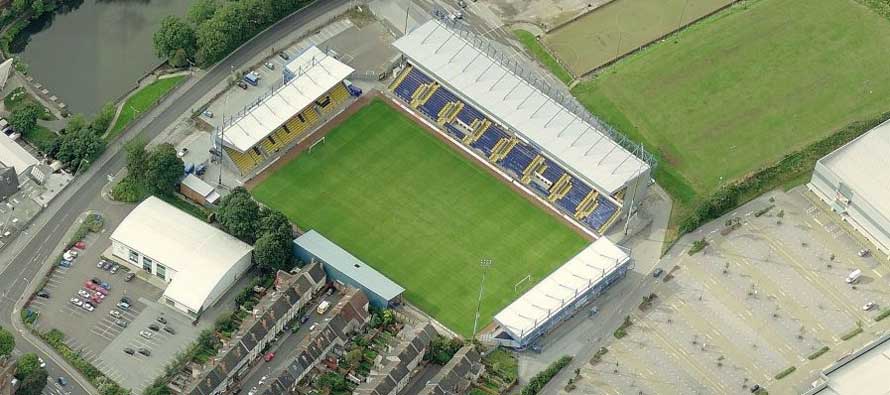As old as football is, so are the stadiums that have hosted matches since time immemorial. With that, it shouldn't come as a surprise that some of the old famous venues are located in the U.K.
In retrospect, the evolution of modern football can be traced back to the U.K., sometime in 1863, when the English Football Association formulated the rules that continue to govern the beautiful game.
This post walks you through the grounds that have stood the test of time and are now recognised as the oldest football stadiums in the world. While some have undergone minimal changes, others currently rank among the biggest stadiums in the world.
As football has evolved, so have the stadiums that marked the birth of a sport that is followed more than ever today.
Keep reading to find out which UK stadium takes the top spot.
The oldest football stadiums in the world
El Molinon Stadium, Spain (1908)


Home to the Spanish football club Real Sporting de Gijon, the El Molinon Stadium is among the oldest football stadiums. It has a capacity of 29,029, making it the 20th-largest stadium in Spain and currently the oldest professional football stadium in Spain.
The stadium's name is ‘El Molinon,' loosely translated as ‘Big Mill'. It is situated on the site of an old water mill.
Notably, there are plans to upgrade El Molinon by adding 9,000 seats. As Spain's oldest professional football venue, Sporting Gijon's home ground is undoubtedly significant in Spain's history.
The upcoming upgrade for the 2030 FIFA World Cup will result in significant changes, particularly to the existing infrastructure that fans have become accustomed to over the years.
Spain’s oldest football venue is set for a dramatic makeover ahead of 2030’s centenary #FIFAWorldCup. Under designs from Sordo Madaleno, the El Molinón Stadium will be wrapped in a new unifying red facade and a “gastronomic corridor” filled with bars and restaurants. pic.twitter.com/Avo17jgrJ7
— World Stadiums ? (@Worldstadium23) February 21, 2024
Hampden Park Stadium, Scotland (1903)

The home of Scottish football is next on the list as one of the oldest football stadiums. However, it may be confused with another stadium, also named Hampden Park, that pre-dated this venue.
There were three Hampden Parks in total. The first one, Queens Park, was built in 1873 and was Scotland's oldest football club.
They moved out in 1883 and settled into the second Hampden Park until 1903. The second Hampden Park was renamed Caitlin Park and hosted the now-defunct Third Lanark AC.
They finally settled into the third Hampden Park and played there up as recently as 2021. They are set to return to the venue for the 2023-2024 season.
Hampden Park has hosted several major tournaments, as well as the Scottish Cup Final every year. Most recently, it served as a host stadium for the pandemic-delayed Euro 2020 tournament.
It's now set to undergo major renovations ahead of Euro 2028, which is expected to be hosted by the UK and the Republic of Ireland.
Beyond that, there are rumours that the Scottish Football Association could look to build a new national stadium. Some people believe the fans are too far back at the stadium, hurting the atmosphere. At this stage, nothing is confirmed.
Gran Parque Central Stadium, Uruguay (1900)


The oldest stadium in the Americas is home to the Uruguayan football club Club Nacional de Football. It has a capacity of 34,000 and was one of the venues used in the first-ever World Cup finals, hosted in Uruguay in 1930.
It also has historical relevance to Uruguayans because, before the ground's construction, this was the location where Uruguay's national hero Jose Artigas, was named the leader of the country in 1811.
Georgios Karaiskakis Stadium, Greece (1895)
Finding our way into the 19th century for the first time on the list, we have the home of the Greek side, Olympiakos. The Georgios Karaiskakis Stadium has a capacity of 33,334 and is named after the Greek national hero. The venue was known as the Neo Phaliron Velodrome until 1964.
Georgios Karaiskakis Stadium hosted the first-ever modern-day Olympic Games in 1896.
Georgios Karaiskakis is one of the largest stadiums in Greece and has hosted several exciting competitions.
On 24 August 2023, the venue hosted the UEFA Super Cup between Man City and Sevilla. UEFA rates it four stars, indicating that it has the capacity and facilities to host a Europa League final.
Portman Road, England (1884)

Next on the list is the home of the English side Ipswich Town, where they moved from their previous playing field of Broomfield Park. Technically, Portman Road has been around since 1855.
It initially hosted cricket matches. However, it was established as a football stadium until Ipswich moved in, so 1884 is the date we are sticking with.
Today, Portman Road has a capacity of 29,673 seats, a massive improvement from the original capacity of 22,600.
Anfield, England (1884)

Anfield Stadium is famously home to Liverpool FC. The stadium has hosted some of football's most memorable matches in both the English domestic league and the European stage, but it wasn't always this way.
Liverpool's Merseyside rivals, Everton, were tenants at Anfield for the first seven years of the ground's existence.
However, a rent dispute involving the club's president forced the Blues to move to Goodison Park, a few hundred meters away, with the newly formed Liverpool FC taking up residency a year later.
There have been rumours of Liverpool leaving Anfield, but the club has put to bed any chance of that happening with the recent renovation work, which has seen the capacity increase to over 60,000.
Turf Moor, England (1883)


Home to Burnley FC, Turf Moor is one of English football's more old-school grounds. With its four stands closely hugging the pitch, it has the claim to fame of being the first stadium in England to host a visit by a member of the Royal Family.
Prince Albert Victor watched a game between Burnley and Bolton Wanderers at the venue in 1886.
Sport has been played around Turf Moor for centuries, with the adjacent cricket ground outdating the football stadium, and an attempt at a horse-racing circuit being made earlier in the 19th century.
Ewood Park, England (1882)

Ewood Park is one of the oldest football stadiums in the world. Originally known as ‘Ewood Bridge', Blackburn Rovers played four matches there in 1882. They didn't return to their spiritual home until 1890, but have been playing there ever since.
Blackburn Rovers were one of the founding members of the Football League and are one of only two clubs to have won the FA Cup three times consecutively (1882-1885). The other club was Wanderers FC (1875-1878).
St. James' Park, England (1880)

St. James' Park in Newcastle upon Tyne, England, is one of the oldest stadiums in the world. It was inaugurated in 1880, almost a century and a half ago.
The 52,000-capacity stadium has undergone significant renovations over the years and is today one of England's most iconic football grounds.
Endowed with a rich history of the club's progress and success over the years, St. James' is not only one of the oldest stadiums in the world but is equally a centre of excellence.
Newcastle started using St. James' Park in 1892. However, even with the venue's current magnificent appeal, conflicts often arose from expansion attempts, especially with the local council and residents.
The conflicts arising from the stadium's expansion contributed to the lopsided yet unique appearance of some St. James' Park stands. Overall, that has caused the height discrepancies seen in the various stands at the venue.
Still, even with some news sources in England indicating that the Magpies are planning to leave the iconic football ground, fans prefer to stay at St. James' Park to preserve the memories of the venue.
A Black & White wall at St. James' Park will undoubtedly create a stronger identity among the Magpies. With the planned upgrade set to increase the stadium's capacity to an estimated 65,000 seats, St. James' Park will rival the biggest stadiums in English football.
With that, Newcastle are planning a comprehensive upgrade at St. James' Park, including setting up a black & white wall in the Gallowgate Stand, similar to the Yellow Wall at Borussia Dortmund's Signal Iduna Park.
Being home to Newcastle United for over a century means plenty to see inside the stadium. From club honours and the dressing room to listening to stadium guides tell tales of legendary players who graced the turf, a tour of St. James' Park is richly rewarding.
Deepdale, England (1878)

In the north of England, we have the home of Preston North End, another one of football's first clubs. The land around the ground was first leased for sport in 1875 by the North End Sports Club, which primarily played cricket and rugby.
The first football match played there was on 5 October 1878, and it has hosted Preston North End matches ever since. The club was one of the dominant forces of early professional football.
Deepdale has undergone constant renovations since its birth in 1878, with particularly notable recent updates in 1995, 1998, and 2001. A fun fact for you: North End allowed female spectators to attend matches at Deepdale for free in the early days.
When several thousand women turned up to claim their free tickets for one game, they abandoned that policy on economic grounds!
Rodney Parade, Wales (1877)
This stadium is somewhat of a cheat, as it only became a football stadium as recently as 2012 when Newport County moved in. The Welsh side moved from Newport Stadium, initially on a three-year deal, but that was soon extended.
Being among the oldest football stadiums in the world, the ground has been used for the sport since 1877, when the Newport Athletic Club, which played cricket, tennis, and rugby and practised athletics, secured the rights to use the ground from Godfrey Morgan, the 1st Viscount Tredegar.
- Fun fact: Rodney Parade was the first ground in Wales to have floodlights installed in 1879 when a rugby match was played under the lights.
As one of the oldest football stadiums, it only had a capacity of 7,850 (for football matches) and was mostly used for rugby and cricket until 2012. But it gets added to the list—just about.
Stamford Bridge, England (1877)

Also built in 1877 is West London's Stamford Bridge. Used by London's Athletic Club from 1877 until 1905, the stadium was then made the home stadium of Chelsea FC.
Stamford Bridge has a capacity of 40,343. It was used as the venue for the FA Cup final on three occasions: 1920, 1921 and 1922. The final moved to the newly built Empire Stadium in Wembley in 1923.
Peculiarly, all three Stamford Bridge finals ended in a 1-0 win, none of which Chelsea were involved in.
Chelsea could look to move away from Stamford Bridge in the coming seasons, but as it is a listed building, there is little chance of the stadium being demolished. With that, it will remain one of the oldest football stadiums in the world.
Tannadice Park, Scotland (1870)

Home to Dundee United, Tannadice Park is officially the oldest football stadium still in use in Scotland. Plenty of clubs have played here, with the ground's current capacity at 14,223.
Tannadice only became the stadium's name in 1909, as it was previously known as Clepington Park. It is also located only 200 yards away from Den's Park, occupied by their city rivals, Dundee, making them the closest professional stadiums in the UK, just about beating Anfield and Goodison Park.
Carlisle Ground, Rep of Ireland (1862)

A surprise inclusion in the list of the oldest football stadiums is Ireland's Carlisle Ground. The stadium is currently the oldest football ground in Ireland.
It has hosted three League of Ireland clubs in its history, with Transport FC, Bray Unknowns, and the current occupants, Bray Wanderers, all having played there.
This is not just a football stadium; the ground has been used as a film set and a location for music videos in recent years.
Scenes from Michael Collins were filmed there, whilst Dermot Kennedy's hit, ‘Outnumbered', had its music video shot on the pitch. It currently only has a capacity of 2,500.
Field's Mill, England (1861)

Mansfield FC do not usually rise high in the table, but in this case, with their stadium, they do. Originally used as a recreational field for the employees of Greenhalgh & Sons Works, it wasn't until 1919 that the current Mansfield FC would move in.
Although its capacity of 9,186 makes it rather small, it has all the charm of an old-school stadium. That's despite its renovation work from 1999 to 2001, when all the stands were demolished and rebuilt.
Goodison Park, England (1892)

@oldpicposter
A rental dispute with Liverpool at Anfield led Evertonians to relocate to Goodison Park. It was the first major multi-purpose stadium in England. Additionally, it is one of the oldest football stadiums, serving as a significant landmark in the country.
Moreover, Goodison Park has hosted some of the most memorable matches, most notably the 1966 World Cup semi-final.
But even with the great moments and atmosphere that Goodison Park has offered football fans, Evertonians are set to bid goodbye to the hallowed grounds at the end of the 2024/25 EPL season.
After 133 years, Everton have moved to Bramley-Moore for the 2025/26 season. The new home of Everton has a capacity of at least 52,000, which is suitable for a club deeply rooted in the UK's football history and boasting a massive number of fans.
Being one of the oldest grounds in England means Goodison has hosted some high-profile matches, including international fixtures. Interestingly, the stadium has also hosted the highest number of matches in the English top flight.
With that, even with the club set to move to Bramley-Moore Dock, Goodison Park's legacy will remain one to beat in the years to come.
The highest-attended fixture at Goodison Park was a Merseyside Derby when Everton and Liverpool clashed in the 1948 Division One fixture. A record 78,299 fans attended the match.
In 1894, Goodison Park hosted an FA Final clash between Bolton Wanderers and Notts County, becoming the first Football League ground to do so. Moreover, in 1966, Goodison Park hosted five FIFA World Cup matches.
Other neutral competitions held at the venue include U-18 and U-21 UEFA fixtures, as well as matches between England and other countries.
It begs the question, what will become of Goodison Park once Evertonians abandon it?
A report presented to the Liverpool Council planning committee details the future of the 3.39 hectares of land currently occupied by Goodison Park.
The Goodison Legacy project will involve redeveloping the venue for mixed-use, including commercial and residential projects, as well as community spaces.
Bramall Lane, England (1855)


Many football fans worldwide consider Bramall Lane the oldest stadium still in use. But it's not.
Home to Sheffield United since 1889 and previously to the world's first-ever football club, Sheffield FC, Bramall Lane is still a historic site that football fans should visit.
It has a capacity of 32,000 nowadays and is an all-seater stadium, meaning it probably isn't as old-school as some football fans would like it to be, considering its age.
Still, it's the third-oldest stadium in the world, and some regard it as the ‘Home of Football'.
Racecourse Ground, Wales (1807)


The Racecourse Ground in Wrexham is one of the oldest football stadiums in the UK that still hosts professional football matches.
It is currently home to Wrexham, a club that has been plunged into the limelight in recent years after being acquired by Hollywood actors Ryan Reynolds and McElhenney in 2021.
The stadium was first built in 1807, but it didn't host a football match until 1864. It's officially the oldest international football stadium in the world, having staged the first-ever Wales match back in 1877.
Despite ranking among the oldest football stadiums, the Racecourse Ground has largely remained unchanged over the years.
However, heavy renovation work is currently underway at the stadium as the new owners seek to modernise the club and propel it towards the top of British football.
Sandygate, England (1804)

The Guinness Book of Records recognises Sandygate Stadium in Sheffield as the oldest football stadium in the world. It has been in use since 1804.
Hallam FC currently plays its matches there. With a capacity of 1,300, of which 250 are seated, we suspect not many people have visited this stadium.
The most famous match played here was probably the first inner-club football match between Hallam FC and Sheffield FC, which took place on 26 December 1860.
So, while Hallam can only claim to be the second-oldest football club in the world, they can say they have one of the oldest football stadiums in the world.

